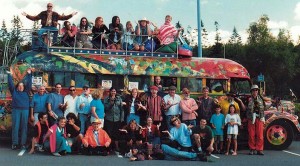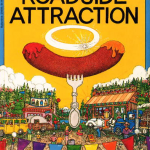
For a campus of white columns and blue blazers, Washington & Lee’s literary C.V. reads like a countercultural manifesto. Our own walking paradox, Tom Wolfe, made a name for himself writing about LSD then sunk his profits into a wardrobe full of genteel, cream-colored suits. But in the shadow of Wolfe’s New Journalism, another hippie-driven author passed through W&L: Tom Robbins. Known for his works Another Roadside Attraction and Even Cowgirls Get the Blues, Robbins pushes Wolfe’s summer-of-love subject matter through a narrative kaleidoscope until manic novels emerge on the other end. But wait, one asks, why haven’t I heard about this member of the W&L community before? Are Robbins’ books in the alumni publications section in the Bookstore? In the library?
Unlike Tom Wolfe, a star athlete and 1951 graduate, Robbins attended Washington & Lee from 1951-1952 before leaving at the end of his sophomore year. Robbins’ early departure from Washington & Lee, then a distinctly Southern college, would seem to mark a personal break from convention, a rejection of the traditions in which he was raised. The son of a second-generation Baptist minister from North Carolina, Robbins weaves the tobacco-plains of his native state throughout his work, particularly his debut novel, Another Roadside Attraction.

- Plucky Purcell, a member of the tie-died ARSA cast, embodies the Washington & Lee literary paradox to such an extent one can’t help but wonder if this character reflects Robbins’ own experiences. A mischievous gentleman who graduated from Duke, Purcell infiltrates the Vatican and accidentally discovers the corpse of Christ, shedding light on a centuries-old conspiracy; of course, Plucky plans on exposing the Catholic hoax with said remains in favor of a 1969 society based around free-love and psychedelics.
Thus, Robbins injects some of the South’s primary literary concerns into his anti-establishment, anti-religious work. Echoing Faulkner and O’Connor’s struggles with the darker side of Western Christianity, Robbins praises Jesus of Nazareth’s fundamental message, while blasting the righteous oppression of the High Church.
So, as one of the South’s postmodern literary figures, why is our campus almost empty of references to the (halfway) alumnus? Robbins’ books are, in fact, available in the “Alumni Publication” section of our library, but, unlike our other literary Tom, there is no Robbins Lecture Series, nor any inspiring Tom Robbins posters strewn about campus. Is this a Vatican-esque conspiracy by the W&L administration to keep a drop-out off the radar? Doubtful, but who would really believe such a place produced two of the psychedelic era’s loudest voices?
*Biographical information gathered from famousauthors.org
*Copy of Another Roadside Attraction provided courtesy of Leyburn Library, and was the Ballantine Books (New York) edition, published in 1971.
